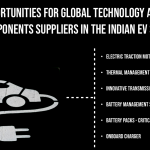How can OEMs maintain a homogeneous pack temperature?
What powers electric vehicles is also its pain point. With climate change reaching a tipping point, the Indian government is making a big push for electric vehicles (EVs) and they are expected to be the new means of mobility. However, a major factor limiting its mass adoption in a country like India, with very hot summers, is the battery technology powering such vehicles. Due to the high cost of lithium ion batteries, the total cost of ownership of EVs is higher as compared to ICE vehicles. The battery accounts for about half the cost of Electric Vehicles. The owner can only get an ROI if these batteries offer a long battery life and don’t have to be replaced frequently.
In my previous blogs, I have spoken about how thermally managing and controlling the battery pack temperature within the optimal zone with the help of LHS materials can increase the battery life by upto 40%. Do click the link at the bottom of this blog to read.
In this blog, I will be focusing on a couple of other important factors contributing to the life cycle of battery packs – maintaining a homogeneous pack temperature and controlling the increase in temperature difference in the pack during fast charging.
Li-ion cells, irrespective of their geometry, dissipate heat from some areas more easily than others. The charge/discharge current densities and therefore heat generation rates are not equal at all locations within the pack. The varying temperatures and currents result in uneven reactions and degradation. High local temperature gradients further increase local current densities, causing dendrite growth and may even result in short-circuit in the cells during charging.
Uneven heat generation is not solely a cell-level effect. On a pack level, layout and thermal management system design affects the temperature variations within a pack. Many times, interior cells of a battery pack are not able to dissipate heat as effectively as exterior cells that are in contact with the enclosure causing some cells to degrade faster than the others. Over time, due to unequal rise in cell resistances, individual cells can also affect the homogeneity of heat generation in an aged pack. The resulting temperature gradients may, in turn, further aggravate the differences in the aging behaviours between cells.
Apart from this, the long charging times of EVs compared to the shorter refuelling times of ICE vehicles is also often quoted among the main issues delaying wider adoption of EVs. However, charging at high rates has been shown to accelerate degradation, causing both the capacity and power capability of batteries to deteriorate. The heat generated during fast charging due to resistive heating is often difficult to remove in a uniform and efficient manner, leading to accelerated degradation and safety concerns.
The Solution:
LHS materials encapsulate each cell individually, thus thermally micromanaging each cell individually and not allowing the cells to reach a high temperature, preventing temperature gradients and dendrite growth within the cells.
On a pack level, LHS materials help maintain all the cells at similar temperature throughout the pack, thus eliminating hotspots and preventing uneven degradation of cells.
The graph below shows a study carried out by a German university – Hochschule Aalen on packs with and without LHS materials with NCR 18650 cells. As can be seen in the graph, as the C rate increases both the temperature and temperature difference between the interior and exterior cells of the pack . However, in the pack with LHS material, the interior and exterior cells are maintained at an overall lower temperature and approximately the same temperature thus giving a homogeneous pack temperature throughout the pack, even during fast charging.
To learn more about LHS materials or to use them in your battery packs, do get in touch with me at ashutosh@quanzen.com






